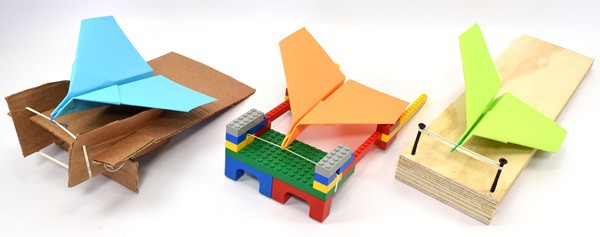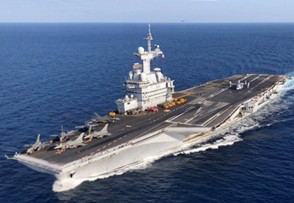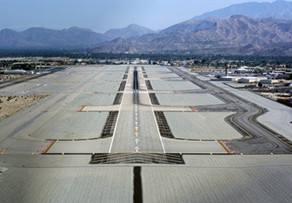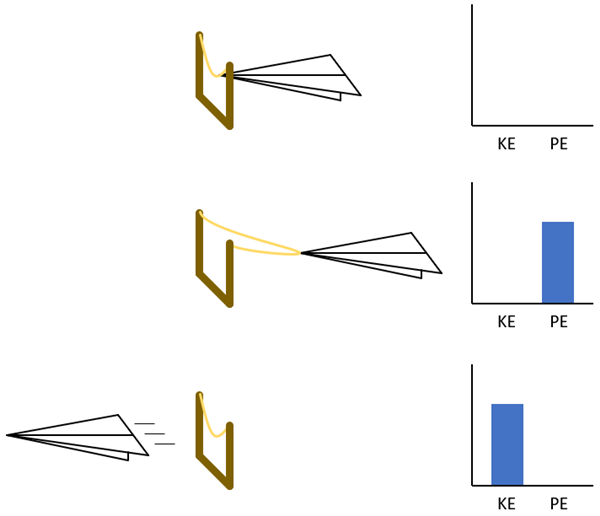Design a Paper Airplane Launcher
Summary
Overview
Aircraft carriers are much shorter than a typical airport runway. How do airplanes manage to gain enough speed for takeoff over such a short distance? A catapult gives them an extra boost! In this lesson, your students will practice engineering design as they build their own paper airplane launchers, while learning about kinetic and potential energy.
Learning Objectives
- Use the engineering design process to design, build, and test a paper airplane launcher
- Understand how potential energy is converted to kinetic energy when using the launcher
NGSS Alignment
This lesson helps students prepare for these Next Generation Science Standards Performance Expectations:- MS-PS3-2. Develop a model to describe that when the arrangement of objects interacting at a distance changes, different amounts of potential energy are stored in the system.
- MS-ETS1-4. Develop a model to generate data for iterative testing and modification of a proposed object, tool, or process such that an optimal design can be achieved.
|
Science & Engineering Practices
Constructing Explanations and Designing Solutions.
Apply scientific ideas or principles to design, construct, and test a design of an object, tool, process or system.
|
Disciplinary Core Ideas
PS3.A: Definitions of Energy.
A system of objects may also contain stored (potential) energy, depending on their relative positions.
PS3.B: Conservation of Energy and Energy Transfer. When the motion energy of an object changes, there is inevitably some other change in energy at the same time. ETS1.B: Developing Possible Solutions. A solution needs to be tested, and then modified on the basis of the test results, in order to improve it. |
Crosscutting Concepts
Energy and Matter.
Energy may take different forms (e.g. energy in fields, thermal energy, energy of motion).
The transfer of energy can be tracked as energy flows through a designed or natural system. |
Materials

Paper airplane launchers made from different materials. Left: cardboard. Center: LEGO® bricks. Right: Wooden board and screws.
- Paper
- Paper clips
- Tape
- Rubber bands
- Tape measures
- Stapler
- Construction materials to make paper airplane launchers. You can use different materials depending on what you have available, for example:
- Corrugated cardboard and duct tape
- Wooden craft sticks and a hot glue gun
- Building toys like LEGO® or K'NEX®
- Wooden boards and nails or screws
- Open space to throw the airplanes. A hallway or large room like a gymnasium or cafeteria work well. This project works best indoors unless there is almost no wind outside.
Background Information for Teachers
This section contains a quick review for teachers of the science and concepts covered in this lesson.Aircraft that take off from airport runways accelerate under their own power. The planes must get going fast enough to generate enough lift to get off the ground. So especially for large, heavy planes, airport runways are typically very long (over a mile) to make sure the planes have enough room to get up to speed.
This poses a problem for aircraft carriers. The largest aircraft carrier is just over 1,000 feet long, or just under a quarter of a mile. That's really big for a ship—but not that long for a runway! In order to take off from such a short runway, planes need some help to get enough speed. They are assisted by a catapult, which provides extra energy from an outside source (like compressed air or electromagnets) to help the plane go faster.
 Image Credit: United States Navy / Public domain
Image Credit: United States Navy / Public domain
 Image Credit: Wikimedia Commons user Don Ramey Logan / Creative Commons Attribution 4.0 International
Image Credit: Wikimedia Commons user Don Ramey Logan / Creative Commons Attribution 4.0 International
Figure 1. An aircraft carrier (left) and an airport runway (right). Palm Springs International Airport photo D Ramey Logan.jpg from Wikimedia Commons by D Ramey Logan, CC-BY 4.0.
This scenario provides a great real-world example that you can use to teach your students about both physics and engineering design. In this lesson, your students will build rubber-band powered paper airplane launchers. A stretched rubber band stores elastic potential energy* (the energy an object stores when it is stretched or compressed). When the rubber band is released, that stored potential energy is converted to kinetic energy (the energy an object has due to its motion) of the paper airplane (Figure 2). The large amount of potential energy stored in the stretched rubber band allows you to launch the paper airplane over a short distance compared to how far you would move the airplane when launching it by hand—just like the catapult on an aircraft carrier allows an airplane to take off on a short runway!
 Image Credit: Ben Finio, Science Buddies / Science Buddies
Image Credit: Ben Finio, Science Buddies / Science Buddies
Figure 2. Diagram showing how the potential energy of a stretched rubber band (PE) is converted to kinetic energy of the paper airplane (KE).
This project also helps students practice the engineering design process, because building a good paper airplane launcher requires some thought. It must be sturdy enough to withstand the forces from the stretched rubber band. They must also make sure the paper airplane does not get caught or collide with the launcher itself as it is launched.
*Elastic potential energy is the type stored in a stretched or compressed material, like a rubber band or spring. There are other types of potential energy, like gravitational potential energy (the energy stored due an object's height off the ground) or electrical potential energy (the energy stored due to separation of electrical charges). Depending on the context, it may be necessary to specify which type of potential energy you are talking about. In this lesson we are mainly talking about the elastic potential energy of the rubber band. However, the paper airplane also has gravitational potential energy when it is raised off the ground or flying through the air.





